First, let me say that I do understand that different people have different definitions of “fun”. One player will enjoy Face Hunter, while other only wants to play the grindy, control decks. However, if you’re tired of the current Rogue meta (or Questline Warriors if you’re at lower ranks), and you want to slow things down a bit, I think that Ramp Druid might be a really interesting choice.
It’s not like the deck is off-meta, and it’s actually getting more popular each day. At the time I got the idea to write this post, it was 5th most popular deck in Legend, and right now it’s 3rd. Not because it’s incredibly strong and it beats most of the competition, not really. It’s actually somewhere in Tier 2 or even Tier 3, definitely not a meta breaker. But a lot of people simply enjoy its gameplay – so if you own the right cards and you haven’t tried it yet, you should give it a go.
I’ll be honest – I’m not enjoying the current Rogue-heavy meta all that much, and Ramp Druid is the deck that got me through it. It was the deck that got me to Legend a couple of days ago and right now I’m in Top 300 with it, sitting at ~60% win rate over 50+ games. If not for it, I would probably take a break until Patch 22.2 hits.
What Is Ramp Druid
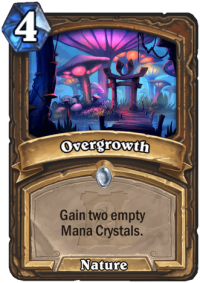
Ramp Druid is a deck basically as old as Hearthstone itself. One of the Druid’s core mechanic is so-called “Ramp”, which means gaining extra mana crystals ahead of the curve. The goal is to sacrifice some early tempo and cards in order to get a massive advantage in the mid game – while your opponent is sitting at 4 or 5 mana, you get to play let’s say 7 or 8 mana worth of stuff, meaning that you can play high impact, late game cards.
And frankly – that’s the most fun part about it. For the last few months, even getting to 10 mana was a difficult task, let alone living enough to play a few 10 mana cards. But with Ramp Druid, unless I draw poorly and get killed early by an Aggro deck, I usually get to survive until the late game and play all of those impactful, big minions. I get to play those fun cards that I normally wouldn’t even put into my deck.
Overall, I wouldn’t call it a “Control” deck per se, but in a meta where it’s almost impossible to play a Control deck, it should be good enough. It’s a slow Midrange deck that’s mostly reactive and defensive, until the late game, where you can start pushing your own threats and turn the entire game around. The deck has some RNG aspects (such as Cenarion Ward outcomes or Yogg), but it’s still consistent enough that you feel like you’re in control of the deck and not vice versa.
Example Ramp Druid Deck List & Tech Choices
This build is usually used as a baseline. It has proven to work well and multiple players have taken it to high Legend with solid win rate. If you don’t really know what decks you will face, it’s probably the “safest” build to use. However, there are some potential tech cards you can employ to make it stronger depending on the common matchups you run into:
- Rustrot Viper – Obviously it’s an anti-weapon tech, but the best part about it is that it’s not a huge commitment either way. Because of Tradeable keyword, even if you face a matchup in which the card is useless, you can always cycle it. Yes, that’s not perfect, since you “waste” 1 mana and sometimes it messes up with your turns, but I found shutting down Poison Rogue worth that trade-off.
- Spammy Arcanist – As you can probably see, what the deck lacks is AoE. Well, not only the deck, that’s what Druid lacks in general. Spammy Arcanist is a Defile on the stick and while you will find it sitting in your hand in many matchups, it can win you a Face Hunter or Thief Rogue matchup by itself. I cleared nearly full boards with it so many times.
- Mutanus the Devourer – A tech against single, big minions you might want to get rid of. It obviously works best against decks that rely on this one minion to pull of some combo – like Mozaki Mage. But you can also sometimes snatch Questline rewards, and it’s great in mirrors (hitting their Y’shaarj, for example, is often an instant win).
If you want to run only one of those tech cards, the most common cut is one copy of Abominable Lieutenant. Two of those can get a bit clunky in some matchups. If you want to add more tech cards, the things you cut are usually Guess the Weight or Lunar Eclipse.
Right now, I run a build with Rustrot Viper + Spammy Arcanist, with one Lieutenant and one Lunar Eclipse cut. That’s what has been working for me, but again, you should look at the meta you face before making those decisions.
Ramp Druid Gameplay & Combos
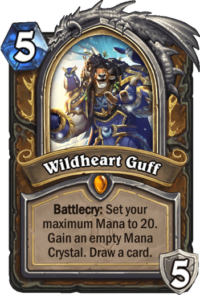
As the name suggests, Ramp is the most important part of the deck. Currently, it runs two main ways to ramp up – Overgrowth and Wildheart Guff. Guff is the main reason why it took off in the first place – the card is just both fun to play and actually quite strong. It turns what would be a really bad deck into a deck you can actually hit high Legend with, because it solves two main issues in one – mana and card draw. Guff is a 100% keep and it’s the most important card you’re trying to find in your deck. For example – if you play Moonlit Guidance and you can either get a Guff or something that you will play immediately to take advantage of the extra draw – you’re going to pick Guff 99% of the time. Yes, that’s how strong it is in Ramp Druid. You usually spend your first few turns using Hero Power to gain extra Mana Crystals (remember that it gives you a FULL Crystal, so it technically only costs 1 mana if you start with that), and then once you go above 10 mana, or if your hand is really weak, you want to start drawing and keep doing that for the rest of the game. If you’re running low on cards, you can stop drawing again to not get into fatigue too quickly (although that’s rarely a concern).
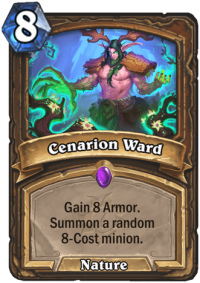
But what is the deck’s win condition, exactly? Against faster decks, it’s always as easy as “survive” – and that’s basically it. If you run into Poison Rogue or Face Hunter, as long as they don’t kill you, you win the game. If you stabilize with enough Armor and Taunts, the game is usually over. The easiest way to close out games against Aggro is Cenarion Ward + Strongman combo. This way you summon two big threats, one of which has Taunt, you gain 8 Armor on top of that. Ward is even better if you manage to play it together w ith Solar Eclipse – now it’s 2x 8 mana minion + 16 Armor. Try your best to set those up against Aggro. There’s also Ivus, the Forest Lord, which is really useful in all matchups, but mostly against Aggro decks that run no big removal. One way to snatch a win against Aggro is to play temporary mana (Lightning Bloom) and drop a big Ivus. For example, 2x Bloom + Ivus on Turn 5 results in a 11/11 Taunt with Divine Shield and Rush. You clear their biggest threat and force them to go through a 11/11 body, which is not easy. Yes, your next turn is gone, but the most important part is that you stabilize. Of course, against Control you can play Ivus much later, at let’s say 15 mana, and it will be even better – but against Aggro you rarely can wait that long.
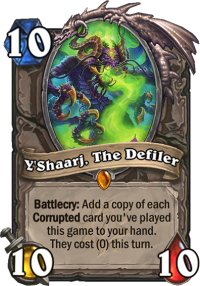
But the thing gets more tricky against slower decks. Here’s where you stop playing defensively and try to push your own threats. Double Cenarion Ward is again a good one to have – not because of Armor, but because it puts so much power on the board. Abominable Lieutenant is great in those matchups, wait until they play something bigger and drop it. This way you not only remove their threat, but also have a growing one yourself – they have to deal with it first, otherwise they can’t really play any more minions because they will die for free. But the best win condition is Y'Shaarj, The Defiler. Not only it’s a 10/10 itself, but you get back all of your Corrupted cards – so Strongmans and Moontouched Amulets. That’s already good, but it gets even better if you Discover an extra copy of Y’Shaarj (that’s your #1 pick in slow matchups) – then it basically fills your hand with Strongmans and Amulets. And well, if things go poorly, you can always pray to Yogg and spin the wheel – most of the outcomes can be beneficial, and even the instant death mode (5% chance) usually favors you given how much Armor you have (in slow matchups, where opponents aren’t damaging you a lot, you might easily have 30+ Armor).
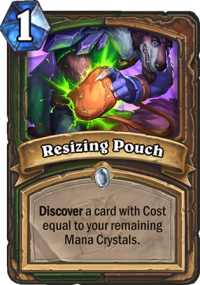
Resizing Pouch is one of the key cards, even though it might not look that way. The best thing about it is that if you play it at 11 or more mana, you will always discover a 10 mana card. The pool of 10 mana cards is quite limited, and many of them are very strong. You have chance to get extra copies of Y'Shaarj, The Defiler or Yogg-Saron, Master of Fate. But even if you miss those, cards like Scrapyard Colossus or Lokholar the Ice Lord can save your skin sometimes (or become really good threats that your opponent has to deal with). Even Darkmoon Rabbit or Deathwing the Destroyer come in handy as pinch removals. Survival of the Fittest provides no instant value itself, but it combos very well with Strongman and Umbral Owl. Of course, you won’t always use Resizing Pouch at 10+ mana – it’s important to more-or-less know the card pool and best cards at each mana slot so you can know which mana point to pick in given situation. If you face Aggro, you can even play it on T1 and try to discover either Innervate or Lightning Bloom to help you get your big turn more quickly. And if you play in a slow matchup, you might want to save your Solar Eclipse to play it together with Resizing Pouch – discovering two 10-mana cards is twice as good as discovering only one (it’s often worth it more than an extra Cenarion Ward).
And I’m frankly just scratching the surface here. The deck can do a lot of interesting stuff depending on the situation, matchups, cards you discover etc. But what I described above should give you a rough idea of how the deck is played and what cards you can look out to. While in some of the matches the deck is very straightforward and pilots itself (e.g. Overgrowth into Guff into double Cenarion Ward + Strongman into opponent conceding), there are many situations in which you have to make some tough decisions. And those are the fun parts in my opinion, but let’s be honest – just dropping those big threats every single turn while not worrying that you will die if you stop removing everything your opponent plays is quite refreshing.
Leave a Reply
You must be logged in to post a comment.


















I’ve had a lot of fun in Wild with C’Thun Guff, so I wanted to try some “Big Boi Guff” in Standard too, but there are SO MANY options of how to play it!
So far I tried Clowns only, but they’re only so-so … is this one better 🙂 ?
Well said.
Ramp druid was my old time favourite and seeing it resurface recently brings me joy.
It is very fun to play, quite versatile and rewarding. Not to mention Guff is by far my favourite character from this year’s storyline and he has the best entrance ever: “Hello, my name is Guff”!
This is one of those good deck, but not great, because it’s heavily rely on getting Guff as hard mulligans.
Turn 2 coins and bloom, and your opponents probably concede at that point.
Not too great if you can’t mulligan ramp cards, or draws, since your deck probably filled with 8+ mana cost cards. yeah. Oh I do miss Highlander Mage so much.
Amen brother. I love this deck mainly for how you can craft different win-cons depending on the matchup.
I’ve had games against Quest Priest where I’ve won with 2 Y’shaarg’s and a silly amount of Moontouched Amulets for a one turn kill.
It highlights what Bliz have done a much better job of this year in terms of generation. Moonlit guidance is probably my favourite card in a while. Super well made card.